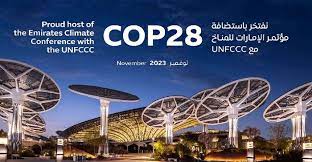By Dr. Fasiha Safdar
The United Nations Conference on Climate Change, also known as Conference of Parties or COP for short, has been held every year since 1995. The aim of these conferences is to fight the threats of global warming and climate change collectively, as the impacts of global warming are universal and cannot be tackled at national levels.
With this year’s COP28 just around the corner, hopes are high among the climate activists worldwide for progress on developing a more robust roadmap to expedite climate action. Although COP27 has been celebrated for the breakthrough agreement on the “Loss and Damage Fund”, the fact that little has been achieved on the path of meeting the goals of Paris Agreement by reducing global greenhouse gas emissions, remains buried under the revelries.
According to Intergovernmental Panel on Climate Change’s (IPCC) sixth assessment report published in 2022, “limiting warming to around 1.5°C requires global greenhouse gas emissions to peak before 2025 at the latest and be reduced by 43% by 2030”. This does not seem likely to occur, given the fact that UN’s first Global StockTake (GST) report released in September this year cautioned that global emissions have not yet peaked.
It was agreed in the Paris Agreement that it may take longer for developing nations to reduce their greenhouse gas emissions, however the goal would be to achieve global peak emissions in 2025 and net zero CO2 emissions by 2050.
GST is a technical mechanism which overlooks and keeps tracks of the progress of the promises made during Paris Agreement and runs a 5-year phase. The technical report of the first GST will be put to table for the parties to discuss at COP28. The end of the first GST and ensuing discussions, which might propose a revised collective goal to pursue, would be highlighting features of COP28.
Despite the breakthrough of the agreement on the loss and damage fund being termed historic, critics of the COP27 have been vocal about absence of any action on reducing emissions and the looming climate emergency. There is a perception that discussions on climate adaptation and mitigation have not proceeded beyond the Glasgow Accord of COP26. Besides this, there has been no consensus on how the loss and damage fund would be operationalized. The decision as to which countries would pay climate reparations and by what proportion is expected to be a point of contention in the upcoming COPs.
The first report of the GST clearly outlines that the global community is not on track to meeting the Paris Agreement goals, as announced in member countries’ Nationally Determined Contributions (NDCs) and calls for expediting of action on climate by all countries and fulfilment on promises of mobilizing funds to fight climate change by rich countries. COP26 and UN’s NDC report just before COP27 requested countries to revise their NDCs to ramp up their domestic mitigation efforts since existing pledges are clearly insufficient to limit the global temperature rise to 1.5°C. Only 34 out of 194 countries have submitted their revised NDCs, with most of the G20 states either being indifferent to the calls or delaying their revisions.
Economic and geopolitical interests of the developed countries guide their decisions to act on climate pledges, hampering the collective progress on the front. COP26 saw heated debates on the term “unabated coal power phase-out” and ultimately ended on the comprised term “phase-down” on China and India’s insistence. COP27 saw resistance from US, UK and EU to the loss and damage fund as had happened in many previous years, with EU agreeing to it suddenly at the end, with UK and US following because of the mounting pressure after EU’s agreement.
Historically, US has been the biggest polluter of greenhouse gases, trailed by EU, China, and Russia. Currently, China is the top contributor, followed by US, EU, and India. These countries would be the ones bearing the most responsibility for the climate reparations after the operationalization of the loss and damage fund.
Another obstacle in meeting the goals of Paris agreement is the lack of funds required for adaptation and mitigation efforts in the developing world, which the low-income countries of the Global South, plagued by their natural vulnerability to climate change and governance malpractices, are unable to raise.
The Global North needs to fulfil its promises of financial aid for climate action; G20 committed to mobilize $100 billion by 2020, but adaptation funds stood at $83.3 billion in 2020 (source: OECD report on climate finance,2022).
Developing countries like Pakistan, which already have less than 1% share in the global emissions have a small role to play in solving the climate crisis. The current scenario should serve as an opportunity for the Global South to grow their economies on clean energy resources in line with local needs and priorities, along with making use of the climate funds to build their climate resilience and adaptation in a transparent way. However, the Global North, which has utilized many natural resources to rise where it stands now, must pay back to nature and humanity at this critical stage, at a point where climate clock is ticking; as UN Secretary-General António Guterres pointed out recently, “the climate emergency is a race we are losing, but it is a race we can win”.
–The writer holds a PhD in EnvironmentalSciences/Climate Change and is currently associated with the National Institute of Maritime Affairs (NIMA), Islamabad. She can be reached at [email protected]






















